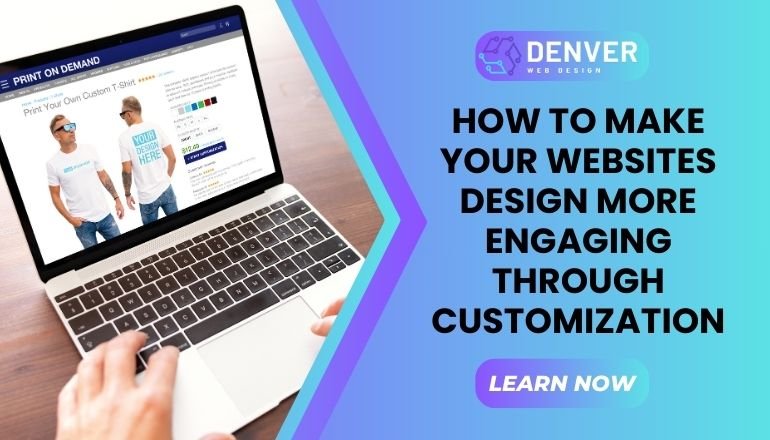
In today’s competitive online landscape, a customized web design can make all the difference in engaging visitors and boosting conversions. Customization allows businesses to create a unique digital experience that not only attracts users but also keeps them coming back.
Whether you’re optimizing for user experience, responsive web design, or ensuring SEO-friendly practices, personalized elements can transform a standard website into a powerful tool for growth. At Web Design Denver, we understand the value of tailored solutions that cater to both your brand’s identity and your audience’s needs.
What is Custom Web Design?
Custom web design refers to the creation of a website that is specifically built to meet the unique requirements of a business, rather than relying on pre-made templates. It includes everything from the visual layout, user interface, and functionality to the choice of colors, typography, and overall theme. A custom approach ensures that the design aligns with the brand’s vision, target audience, and business goals.
In today’s world, customization goes hand-in-hand with responsive web design, meaning the site adapts seamlessly to different screen sizes. Whether a user is visiting from a desktop, tablet, or smartphone, the website provides an optimal viewing experience. Key concepts related to custom web design include “mobile-first design,” “adaptive design,” and “user-friendly interfaces.
Why is Custom Web Design Essential for Your Website?
Custom web design is vital for businesses seeking to differentiate themselves from competitors. When executed well, it enhances the user experience (UX) by creating a tailored interface that speaks directly to the target audience. A website that’s easy to navigate, visually appealing, and functional increases user engagement, which can lead to lower bounce rates and higher conversions.
Beyond UX, customization also plays a pivotal role in SEO. Custom websites are often more SEO-friendly because they can be structured to suit your business’s specific needs, such as optimized load times, clear navigation, and clean code. With SEO-optimized websites, you can improve search engine visibility, helping your site rank higher in Google search results. For businesses looking to boost their online presence, custom web design is a strategic approach that not only enhances user experience but also drives organic traffic.
Key Features/Components of Custom Web Design
To create an engaging website through customization, several key components must be considered:
- Responsive Layouts: Ensuring your website adapts across all devices is fundamental. Whether through a mobile-first approach or adaptive design, your website must look and function great on any screen size.
- SEO-Friendly Structure: Customization allows you to structure your site to follow best practices for SEO, from proper use of header tags to optimized images. Search engine algorithms prioritize websites that are not only functional but also fast-loading and easy to navigate.
- Brand Identity: The design should reflect your business’s identity, including your logo, color scheme, and visual style. A cohesive design will build trust and recognition among your users.
- User-Friendly Navigation: Custom web design allows you to place key components like navigation menus, buttons, and call-to-actions (CTAs) where they make the most sense, ensuring an easy-to-use experience.
- Conversion Optimization: A well-designed website includes clear CTAs, optimized landing pages, and persuasive elements that encourage users to convert, whether through making a purchase or signing up for a newsletter.
Best Practices for Custom Web Design
When embarking on a custom web design project, here are some best practices to follow:
- Focus on User Experience (UX): Prioritize user-centric design by creating clear navigation paths, intuitive site layouts, and fast-loading pages. Implementing UX design principles ensures that users can quickly find what they’re looking for, reducing frustration and increasing time spent on the site.
- Mobile-First Design: With the rise of mobile browsing, designing your site with mobile users in mind is essential. A mobile-first approach ensures that your website is fully functional and user-friendly on smartphones and tablets.
- Optimize for SEO: Structure your website with SEO in mind, ensuring it is easy for search engines to crawl and index. Focus on clear URLs, effective keyword use, and fast page loading times.
- Test Across Devices and Browsers: A custom web design must be tested across various devices and browsers to ensure a consistent user experience. This avoids issues like broken layouts or functionality errors that could negatively impact visitors.
- Regular Updates and Maintenance: Custom websites need regular reviews and updates to ensure they remain secure and relevant. Make sure to update content, fix bugs, and ensure your design still aligns with the latest trends and technology.
Common Mistakes to Avoid
While customizing your web design, there are several common pitfalls to watch out for:
- Overcomplicating the Design: A cluttered website with too many elements can overwhelm users. It’s essential to focus on simplicity, ensuring that the design serves its purpose without unnecessary distractions.
- Neglecting Mobile Optimization: If your website is not mobile-responsive, you’re likely losing a significant portion of your audience. Mobile-first design is no longer optional; it’s a must.
- Ignoring Load Speed: Custom web designs that are too heavy on images, animations, or unoptimized code can slow down load times. Site speed is a crucial ranking factor for SEO and a key element of user satisfaction.
- Inconsistent Branding: Customization should reflect your brand identity consistently across all pages. Inconsistencies in design elements like colors, fonts, or imagery can confuse visitors and damage your brand’s credibility.
Conclusion: Key Takeaways
Custom web design is a powerful way to make your website more engaging, user-friendly, and effective in driving conversions. By focusing on key components like responsive layouts, SEO-friendly structures, and mobile-first design, businesses can create a tailored online experience that not only stands out but also provides measurable results. If you’re ready to elevate your website’s design, start implementing these best practices today to improve user experience, enhance your brand identity, and boost SEO rankings.






